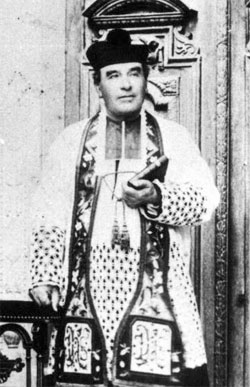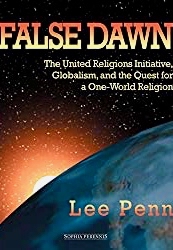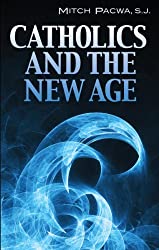
Forenote: Here is another extract from my upcoming book, Cor Jesu Sacratissimum. Yet ripping such fragments out of context is tricky business. Things may not make sense. It may help, if I say explain that my book explores the Theosophical origins of the New Age movement and how its depersonalised, yet supposedly universal philosophy, stands in sharp contrast to Catholicism.
I write as a former member of Findhorn, perhaps the world’s leading New Age community, who found instead the Catholic Mystery of the Sacred Heart. You can read a little that is relevant here, if you like.
But what follows below is just little autobiographical fragment describing New Age attitudes:
Extract: A New Age Pilgrimage to the Church of Rennes-le-Chateau …
Significantly, I became fascinated – as many New Agers do – by the Gnostics. Their depersonalised, aloof variant of Christianity was far more interesting to me than the real thing.

Because alongside most of my New Age cohort, I was persuaded that it was the Gnostics who in fact represented “the real thing”. It was just that the Church had screwed it up.
This opinion had not been formed by carefully comparing Gnostic writings with Christian Theology – it was simply obvious that the Church was wrong.
We New Agers “knew” that in a reflexive, unexamined – and it must be admitted – altogether biased fashion. We did not deem it necessary to study both sides of the issue.
At least, I can honestly say that I have come across any number of Gnostic enthusiasts in the “holistic” movement over the years and I cannot remember meeting a single one who studiously compared traditional Christianity and Gnosticism side by side*.
During this part of my life, I even made a New Age pilgrimage of sorts to the Pyrenees in Southern France. For in the thirteenth century, the Pyrenees were the site of Gnostics, who had been called the Cathars.
This dualistic sect believed in the innate evil of matter and thus, the human body. It was resolutely opposed to the Church and saw no need for Her Sacraments.
And this body-hating, anti–ecclesiastical Cathar spirituality is one that neatly syncs with that of the anti-ecclesiastical Theosophical “control of the lower vehicles”.
In the Pyrenees, I would even visit the little Catholic Church of Rennes-le-Chateau, once served by the Abbé Berenger Sauniere.
But of course, my only reason for entering this particular Catholic Church was that it had been associated (whether legitimately or not is another matter) with that strange complex of anti-Christianity, which later give birth to The Holy Blood and the Holy Grail.
Like so many of my fellow travellers, this was a book I had read avidly in my New Age days. Like them, I became absorbed in the theory that Sauniere was connected to a conspiracy to cover up “the real Christ.”

Today The Holy Blood and The Holy Grail has begotten The Da Vinci Code. And like myself back then, many New Agers lap that book up today without troubling themselves for a instant with the Catholic side.
For them, Catholicism is all-too-obviously suspect, corroded as it all-too-evidently is by ecclesiastical “control freaks”, who are certainly capable of hiding the “fact” that St. Mary Magdelene had been the lover – of Jesus Christ.
For in the vicinity of Rennes-le-Chateau, people whisperered that not only the body of St. Mary Magdelene might one day be found, but also the (non-resurrected) body of Jesus …
Hence, the title of another volume about Rennes-le-Chateau that I perused in my youth: The Tomb of God, a number one bestseller in its day. Today such titles take on new meaning for me: they are indeed about burying God, burying God in our day …
Yes it was with such dubious inspirations as these, that I made my New Age pilgrimage to the little Catholic Church of Rennes-le-Chateau. I certainly would not have been interested in entering any other Catholic Church. I was twenty-eight years old. Rennes-le-Chateau was cool, I might have said. The Gnostics and Cathars were definitely cool. Ordinary Christianity was distinctly uncool.
Though as a Catholic in France, many years later, I would return several times to Rennes-le-Chateau and to the final resting place of the Abbé Berenger Sauniere.
Now in the mysterious web of truth and lies around Rennes-le-Chateau, it is indisputable that Sauniere had mysteriously come across a fortune, with which he refurbished and redecorated his church with images and statues.
And it is said that one can search the imagery for clues to a mystery. Indeed this is what I attempted in the visit during my period in the New Age.
Missing the obvious: The Traditional Catholic Setting of Rennes-le-Chateau

It was only later as a Catholic that I could see what was far more obvious to anyone with eyes to see. That is, to regard all there was at the Church to suggest the evident piety in Sauniere’s redecoration.
It was only then that I could appreciate all that the priest of the village had done to honour the Sacred Heart.
Only then did I see the statue in stone, the stained glass window and a smaller earthen commemoration, all of which the Abbé had clearly commissioned in reverence for His Most Sacred Heart.
Only then did it become clear that Sauniere had been a traditional Catholic monarchist in a mold similar to that of Josephin Péladan.
But there is nonsense everywhere, which obscures vision. And the very traditional Catholic elements of Rennes-le-Chateau were as invisible to my blinkered New Age eyes, as they are to the vast majority of contemporary “pilgrims” to the site.
For whenever I visited Rennes-le-Chateau as a Catholic, there were streams of New Age visitors there, just as I myself had once been. And I imagine that generally they searched out the obscure – looking for clues of conspiracy and cover-up – while completely ignoring the obvious.
For not only are their numerous indications of the Sacred Heart erected by the Abbé Sauniere – there is also his statue to Our Lady of Lourdes, crying “Penitence! Penitence!” – words which he had taken care to inscribe at the base of the statue, in order to instruct his tiny parish.
My digression here is not without purpose. Among other things, I mean to suggest how apparently different New Age threads converge.
Opposition to ecclesiastical Christianity marks such apparently diverse New Age favourites as Alice Bailey, Krishnamurti, the Cathars, A Course in Miracles, The Da Vinci Code and more.
As diversified as they (apparently) are, they are united in this: they not only cast aspersions on the institution of religion, they each have little space for the Jesus of whom the Church teaches.
That is to say, Jesus Christ, who is both Second Person of the Trinity, as well as incarnate, personal and human.
And in a manner that is not always so readily explicit – though it often is! – such approaches can tend to a spirituality, which is also less than personal and human …
Foreword for Monarchy by Roger Buck
*Footnote: I speak here of dozens I have met in the flesh. It should be said that there is very small minority of New Age sympathisers who have undertaken such comparison in books. Perhaps most notable of these is Kenneth Wapnick, a devotee of A Course in Miracles, whose writings would seem clearly to stem from a prior certainty of the superiority of Gnostic texts and the Course to ecclesiastical Christianity.

Buying Books at Amazon Through These Links Gives Us a Commission. This Supports Our Apostolate. Thank You if You Can Help Us Like This!







Comments
comments are currently closed
One response to “On Rennes-le-Chateau, the Cathars, the New Age and the Da Vinci Code …”
Sauniere clearly started out as a faithful Catholic, but the discovery he made, whatever it was exactly, brought him into contact with a secret society with powerful connections. His activities were subsequently financed by wealthy members of this group (explaining his sudden introduction to a social circle of celebrities, aristocracy etc). It is possible that the involvement with these people ended up compromising him in some way, entangling him with something he hadn’t initially understood for what it was, for it is reported that the priest who visited him on his deathbed for the last rites was horrified by what Sauniere had told him during confession. So Rennes le Chateau is not only associated with the Christian mystery — it opens a door into the dark underworld of the secret societies (what René Guénon termed the ‘counter-initiation’) also.
One follower of Guénon (I am not sure if he is an orthodox Catholic Christian, but possibly) who has critically examined and analysed the Rennes le Chateau mythology is Jean Robin, and he apparently concluded that much, although I haven’t read his book yet as I do not know enough French. Maybe you will find it worth looking into.
Interesting read. I was once obsessed with Rennes-le-Chateau and related matters and then I encountered Christ in the Orthodox Church. I still have affection for Rennes-le-Chateau; God uses many things to instil a sense of wonder and mystery in our youthful Hearts though I’m saddened that so many take their godless agendas and delusions to the village and are not truly open.
Sauniere was connected with the Hireon du val d’Or by the way and was a faithful, if sinful, Catholic.
I am very sorry for the ridiculous time in replying. I have been away from this site, which is now about to be majorly revamped and relaunched. The new site launching very soon will have comments closed as I cannot find time for them anymore.
But quickly Niccolo – thank you. I tend to concur though in my quite extensive studies of Sauniere I have yet to see a connection to the Hieron. This is very interesting. If I had not been so negigent with you and were not about to close the comments down, I might ask for a link/reference